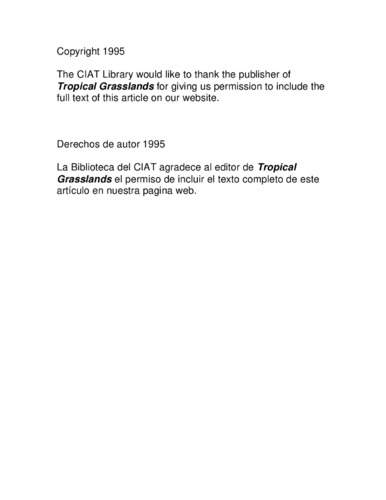Pasture production, diet selection and liveweight gains of cattle grazing Brachiaria brizantha with or without Arachis pintoi at two stocking rates in the Atlantic zone of Costa Rica
Pastures of Brachiaria brizantha (Bb) alone or with Arachis pintoi (Bb + Ap) were rotationally grazed by 3 (LSR) and 6 (HSR) hd/ha. Mean 4-weekly forage DM on offer ranged from 3.5 t/ha at the HSR for Bb to 6 t/ha at the LSR for both pasture types. Mean dry weight proportion of Ap was 6% at the LSR and 34% at the HSR.
The amount of Ap in the diet of steers was about 50% at the HSR and 10% at the LSR. During two 7-day grazing cycles, the mean crude protein concentration of the diet at both stocking rates in Bb and at the LSR in Bb + Ap ranged from 7 9.5%, but at the HSR in Bb + Ap, it ranged from 15 18%. In vitro dry matter digestibility of the diet ranged from 61 66% in all treatments, except for Bb at the HSR in which it fell to 54.1 % on the last day of grazing.
Average daily gain was lowest for Bb at the HSR (291 377 g) and highest for Bb + Ap at the LSR (452 551 g). The mean annual liveweight gain (LWG) per animal ranged from 119 kg for Bb at HSR to 178 kg for Bb + Ap at the LSR. LWGha/yr ranged from 478 kg for Bb at the LSR to 937 kg for Bb + Ap at the HSR. Including Ap increased LWG/ha by 30% at the HSR and 11 % at the LSR. It was concluded that Ap is the best herbaceous legume presently available for the humid tropics of Costa Rica.

